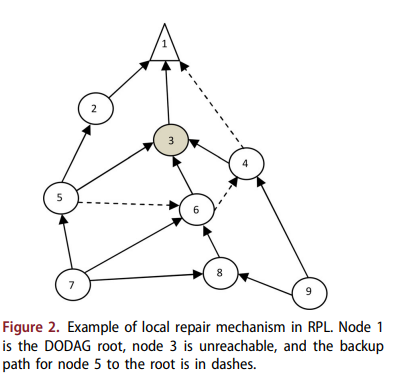Breadcrumb
Arithmetic optimization approach for parameters identification of different PV diode models with FOPI-MPPT
The Maximum Power Point Tracker (MPPT) provides the most efficient use of a Photo-voltaic system independent of irradiance or temperature fluctuations. This paper introduces the modeling and control of a photo-voltaic system operating at MPPT using the arithmetic optimization algorithm (AOA). The single and double Photo-voltaic models are investigated. Their optimal unknown parameters are extracted using AOA based on commercial Photo-voltaic datasheets. A comparison is performed between these optimal parameters extracted by AOA and other optimization techniques presented in the literature

Optimal proactive monitor placement & scheduling for IoT networks
This work is fulfilled in the context of the optimized monitoring of Internet of Things (IoT) networks. IoT networks are faulty; Things are resource-constrained in terms of energy and computational capabilities; they are also connected via lossy links. For IoT systems performing a critical mission, it is crucial to ensure connectivity, availability, and network reliability, which requires proactive network monitoring. The idea is to oversee the network state and functioning of the nodes and links; to ensure the early detection of faults and decrease node-unreachability times. It is imperative
Modeling the Production Planning and Control System using UML
Production planning and control systems are known for their complexity, especially for large scale production units. The Unified Modeling Language (UML) is known for its efficiency in modeling such complex systems for better visualization and as an initial step for software implementation. In this paper, UML is utilized to model production planning and control systems. The models developed include functional, and behavioral models represented through a use case diagram, an activity diagram, and a communication diagram. The proposed models serve as the first step towards implementing a software

Investigation of root causes of order unfulfillment: A Logistics case study
This study targets an order fulfillment problem in a freight forwarding company. Some applicable solutions are implemented such as supplier performance evaluation, suppliers' selection, and location analytics. The objective of the study is to reduce the number of unfulfilled orders by supply planning. Some of the tools used to achieve this are Excel (VBA and Pivot tables) to perform drivers' scoring, analytic hierarchy process (AHP), and ArcGIS software to visualize locations. The results showed that the company can implement the suggested solutions to reduce the number of order cancellations

Optimal Power Consumption on Distributed Edge Services Under Non-Uniform Traffic with Dual Threshold Sleep/Active Control
Mobile edge computing (MEC) is a key enabling technology for supporting high-speed and low latency services in the fifth generation (5G) and beyond networks. MEC paradigm moves computational resources from centralized cloud servers towards the edge of the network, nearer to the users. However, edge computation resources increase the power consumption of the network. Moreover, the non-uniform traffic load on the edge servers causes resources to be underutilized and decrease the system's power efficiency. To achieve the green networking concept encouraged in 5G and beyond networks, unused MEC
Hybrid NOMA-based ACO-FBMC/OQAM for next-generation indoor optical wireless communications using LiFi technology
Light fidelity (LiFi) has successfully achieved high data transfer rates, high security, great availability, and low interference. In this paper, we propose a LiFi system consisting of a combination of non-orthogonal multi-access (NOMA), asymmetrically-clipped optical (ACO), and filter bank multicarrier (FBMC) techniques combined with offset quadrature amplitude modulation (OQAM). The paper also applies a μ-law companding approach for a high peak to average power ratio (PAPR) reduction of the FBMC/OQAM scheme. The combination of NOMA, ACO-FBMC/OQAM, and μ-law companding allows a significant

Real-Time Fish Detection Approach on Self-Built Dataset Based on YOLOv3
Creating a model to detect freely moving fish underwater in real-time is a challenging process for two main reasons. First, the available datasets suffer from some limitations that severely affect the results of the detection models operating in challenging and blurry environments. These models should be able to capture all of the fish movement given different types of surroundings. Second, choosing the convenient detection model system which matches the desired requirements from having high accuracy with satisfying frames per second (FPS). To overcome the first challenge, a new dataset was

Design and Analysis of A Reliable Quadcopter UAV for Wireless Communication Purposes
Unmanned aerial vehicles (UAVs) are used for a wide range of applications, including wireless communication systems, which have the potential to provide cost-effective wireless connectivity for a wide variety of applications. The present UAV models lack the flexibility needed to carry the mission's varied payloads. As a result, appropriate design and analysis of the UAV structure are essential. This work presents a complete design and analysis of a quadcopter UAV for wireless communications purposes, which is carried out using computer-aided design (CAD) tools and techniques. Several design

Radio optical network simulation tool (ronst)
This paper presents a radio optical network simulation tool (RONST) for modeling optical-wireless systems. For a typical optical and electrical chain environment, performance should be optimized concurrently before system implementation. As a result, simulating such systems turns out to be a multidisciplinary problem. The governing equations are incompatible with co-simulation in the traditional environments of existing software (SW) packages. The ultra-wideband (UWB) technology is an ideal candidate for providing high-speed short-range access for wireless services. The limited wireless reach

A detailed survey and future directions of unmanned aerial vehicles (Uavs) with potential applications
Recently, unmanned aerial vehicles (UAVs), also known as drones, have gained widespread interest in civilian and military applications, which has led to the development of novel UAVs that can perform various operations. UAVs are aircraft that can fly without the need of a human pilot onboard, meaning they can fly either autonomously or be remotely piloted. They can be equipped with multiple sensors, including cameras, inertial measurement units (IMUs), LiDAR, and GPS, to collect and transmit data in real time. Due to the demand for UAVs in various applications such as precision agriculture
Pagination
- Previous page ‹‹
- Page 6
- Next page ››
